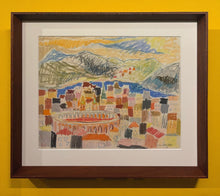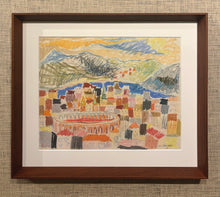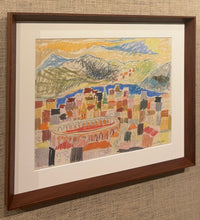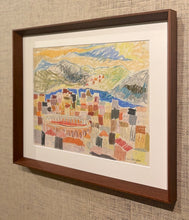
artist: Sven Olow Olsson (Swedish 1924-1971)
medium: pastel on paper
dimensions: 52 x 44 cm framed size (approx)
signed and dated 51
presented in a new angled teak stained timber frame with archival mat and non-reflective UV glass
AU $935 (approx US $615 / 525 EUROS / 91,000 yen / 460 GBP - for exact current conversion visit xe.com)
artist biography
Sven Olow Olsson was born 13 January, 1924 in Sandviken. He was a Swedish painter, draftsman, and graphic artist.
Olsson studied at the Kunstindustriskolen in Oslo from 1949 to 1951, where he was a student of Finn Faaborg. He also undertook private study trips to Norway, France, Spain, the Netherlands, Denmark, and Russia.
His first exhibition took place in Sandviken in 1947, and he subsequently held several more exhibitions in his hometown. Olsson also presented solo exhibitions at Galerie Moderne, Stockholm (1953), Galleri Brinken, Stockholm (1955), and at Modern konst i hemmiljö, Gävle (1954, 1957, 1961). He exhibited at Hälsinglands Museum, Hudiksvall (1952, 1961), Falun (1953, 1956, 1958), Örebro (1955), Bollnäs (1949, 1955), Hofors (1954), and Skutskär (1959, with Johnny Mattsson).
In addition, he participated repeatedly in the annual “Unga Tecknare” (“Young Draftsmen”) exhibitions at the Nationalmuseum, Stockholm, and frequently in exhibitions organized by the Gävleborg County Art Association in Gävle, beginning in 1952. He also took part in numerous touring exhibitions with the Gävleborg Group of artists across Sweden, as well as in the Spring Salon of the Swedish General Art Association, Stockholm (1957) and in the Dalarna Art Association’s exhibition in the same year.
Critical response to his work was strong. Writing in Konstrevy (1953), Emmy Melin noted that Olsson’s Stockholm debut revealed “a painter belonging to the Gävleborg Group, of interest above all through his picture construction, with elements both of Norwegian monumental art and stylised abstraction. He builds his motifs in a checkered pattern and a dense web of lines, producing a mosaic-like structure. The color is heavy and monotonous, but his images of harbors and street scenes are infused with a somber, concentrated intensity.” Later, in Stockholms-Tidningen (2 March 1955), critic M. Strömberg observed that Olsson, “apparently under the influence of Norwegian painting, had adopted a broader manner of presentation. He shows a stronger temperament than painterly sensitivity. When he works in oils the result is often hard and unyielding, but as a watercolorist and draftsman he consistently maintains a higher quality.”
Earlier in his career Olsson found inspiration in the cities of Spain, the Netherlands, and France, but in later years he increasingly focused on the forests, steelworks, and towns of northern Sweden, rendered in a palette of black, brown, and red.
Beyond his paintings and prints, Olsson also worked as an illustrator for Arbetarbladet (Gävle), Gävle Dagblad, and Sandvikens Tidning. He executed mural paintings for Gävle Sparbank, Sandviken, and for the Stadshotellet, Sandviken.
Olsson is represented in the collections ofthe National Museum in Stockholm, the Moderna Museet in Stockholm, Gävle Museum, Hälsinglands Museum, Örebro Municipality, Sandvikens Municipality and the Gustaf VI Adolfs Collection.
He passed away on July 7, 1971 at the age of 46 in Gävle.







